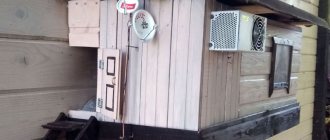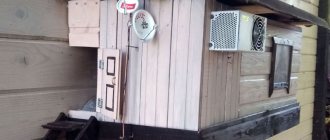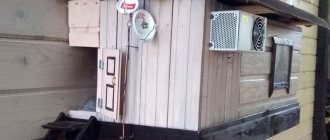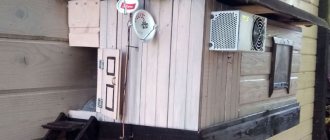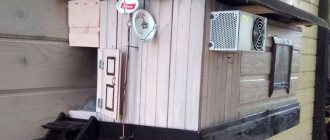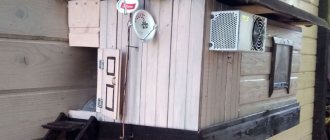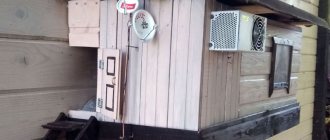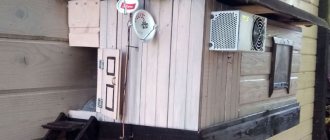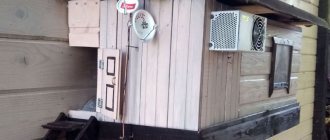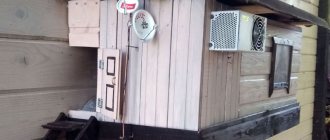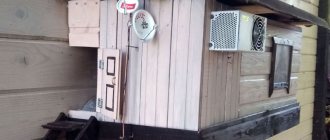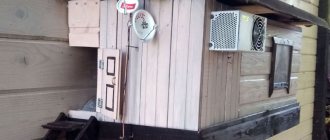Another homemade product for those who are bored at home
I needed a couple of antennas for digital, in places with “not the best reception”... I went shopping (this was before self-isolation - if it’s relatively budget-friendly, then it’s complete G. The more expensive one looks decent, but how it works is questionable.
- if it’s relatively budget-friendly, then it’s complete G. The more expensive one looks decent, but how it works is questionable.
I decided to make something homemade. It was somehow awkward to “twist” an antenna from a piece of cable (although rumor has it it works) - I wanted something simple, but more decent and advanced
In fact, the one I made is not radically more complicated, but somehow more “solid” or something. And the results of its testing were very encouraging, so I decided to sketch out a short description of what and how, in case someone else finds it useful 
... even if my street cats have a “normal” antenna on their house, what can you do without an antenna?!
The wire is not all finished yet, now we’ll assemble something!
In the places described, I previously used home-made broadband log-periodic antennas, probably since the “beginning of perestroika.” They worked well in analog and not only on UHF, but “for some reason, digital was too tough for them.” I didn’t really delve into the essence of the reasons, I removed them and began to think about what to replace them with. Here is one of them, waiting for a place in the trash
They worked well in analog and not only on UHF, but “for some reason, digital was too tough for them.” I didn’t really delve into the essence of the reasons, I removed them and began to think about what to replace them with. Here is one of them, waiting for a place in the trash
A little history
In the early 60s of the last century, our compatriot Kharchenko K.P. developed a simple flat zigzag antenna with good characteristics.
Copyright certificate No. 138277 for an invention called “Band directional antenna” was issued to Konstantin Pavlovich Kharchenko in 1961 (according to his application dated June 16, 1960). In the same year, materials were published in the magazine “Radio” for repetition by radio amateurs.
The antenna is not critical to materials and dimensions during manufacturing, has a simple good match with the reduction cable, and it successfully combines multiple elements of a common-mode antenna array with a single feed point.
Theory and calculations
The described antenna, in theory, has a horizontal “figure-of-eight” radiation pattern and a relatively high gain, which can be further increased by using a reflector/reflector.
To obtain maximum gain on all channels, it is necessary to make an antenna approximately in the middle of the range between the multiplexes used.
Finding (for calculations) the frequencies of multiplexes used in your region is easy,
for example, a request like “dvb-t2 channel frequencies” + “Krasnodar”
I found something like this:
The middle, between “my” two multiplexes, is 700 MHz - we will calculate the antenna at this frequency.
As a basis for calculating the dimensions of the antenna, we take the drawing of its author
Calculate the wavelength: λ = 300 / f [m]
300/700 = 0.428m, approximately 43cm length of each side of the rhombus
λ/4
=43/4= 10.75
The total length of the material we need (11cm*8=88cm) is less than a meter. The distance between the reduction contacts, where we will solder the cable, is 10-12mm (the standard value for this antenna for frequencies below 900 MHz).
I will make a simple antenna, without a reflector, however, to further increase the gain of this antenna, it is quite possible to install it behind it
for example, from a metal mesh/grill, foil material or simply a metal plate. Its dimensions should be approximately 20 percent larger than the dimensions of the antenna and it should be located at a distance of ƛmax/7. For my case: wavelength (channel 39) 300/618, it turns out...49/7= that is, about 7cm
For those who are too lazy to do the calculations themselves
— you can use an online calculator, the results will differ only slightly from those I received. Here, for example, this one - here you immediately enter the frequencies of two multiplexes and get the dimensions of the antenna (without a reflector) Or another option, with a reflector - I really want to note that in the second option a slightly different calculation option is used, different from the author’s. An antenna with angles other than 90° is assumed and the reflector distance is calculated as λ/8
To make the antenna sheet, it is recommended to use aluminum or copper (copper is easily soldered) with a diameter of 3 mm and higher - the larger the diameter, the more broadband the antenna is. You can use tubes; the thickness of the walls is not important, since only the surface of the material is used (in fact, you can wrap any dielectric with foil to obtain the required material). However, in my opinion, the easiest way is to buy a meter of large-gauge copper wire at an electrical supply store.
Delta antenna - how to connect and characteristics
The Delta antenna is in great demand among many TV viewers. First of all, it is chosen for its affordable price, high quality and ease of use. Their production was first launched 17 years ago at a plant operating in the city of St. Petersburg. Over the years, the products have been constantly improved, new functions and capabilities have been added.
During this time, television antennas have proven themselves to be reliable and efficient equipment, the use of which ensures enjoyable viewing of your favorite films and TV shows. Thanks to this, the products are in great demand and are being chosen by an increasing number of television viewers.
High quality material
High-strength steel is used to produce Delta outdoor antennas. Special powder paint is used as a coating. The use of steel by the manufacturer made it possible to set an acceptable price for the products.
The manufacturer offers a wide range of models:
- Indoor television;
- External individual;
- Outdoor models of collective reception;
- Devices for other purposes - for cellular communications, VHF antennas, etc.
Indoor models
The first models began to be produced back in the days of the Soviet Union. This antenna is the only one that does not have a distinctive alphanumeric index. During the formation of the antenna market, it quickly gained great popularity due to its compactness and ease of transportation. However, antennas also had negative sides.
The antennas were completely collapsible and easily broke when dropped. In order to fix this, the developers introduced a new model - Delta K131. K determines that the antenna is indoor. The cost of the new model remained the same, but the quality has become higher. Partial legibility ensured the product's durability and higher drop resistance.
Broadband indoor antennas
The very first model is Delta K331, which became popular in the shortest possible time. The antenna is completely collapsible and very compact; it has a modification supplemented by a powerful power supply and amplifier. The range of manufactured all-wave indoor antennas has been expanded with newer models - K331A02, K331A03, which are less convenient to transport. Modern design, beautiful packaging and good quality have provided them with a high level of popularity.
Outdoor TV antennas
The manufacturer provides for the production of external antennas in two versions: cable and models without cable.
Models of the first type are designated by the corresponding prefix “b/k”. Depending on the model range, the cable length is set differently by the manufacturer. The Delta N311-01 antenna was the first in this model range; it appeared on the market more than 15 years ago, and currently the antenna remains one of the best-selling among the models of the Delta family. The model is time-tested and has proven itself as a reliable and inexpensive antenna.
H311-01 is widespread, in great demand, and is available in two versions:
- N311A-01 is the best option for use outside the city, complemented by amplification in the MV and UHF range;
- H31A1 is an excellent example for urban conditions. Due to the similarity of the letter designations, the two different models are often confused.
The wide range of Delta antennas presented by the manufacturer will allow everyone to choose the best option.
Device types
Products of the “Wave Channel” type have become widespread among consumers. Their main differences are high gain and narrow radiation pattern. The second category is log-periodic antennas, which have a similar design, but a completely different operating principle.
The manufacturer has proposed a universal Delta antenna, the use of which ensures high signal quality. The existing differences between indoor and outdoor options are determined by the number of working elements and overall dimensions. Using an outdoor model will provide better reception than an indoor one. The advantage of the internal one is its compact size. Despite this, using the device in close proximity to the transmitting center will allow you to achieve high signal quality.
Design
Delta products are a combination of a half-wave field that provides reception of dead-range channels, a wave channel and a log-periodic antenna that provides reception of high-frequency decimeter waves. Coordination of both parts reduces mutual influence on each other and improves the level of reception quality.
Characteristics of outdoor models
- Frequency indicators – MV, UHF;
- 3-14 dB – gain parameter;
- The protective effect of the devices is 12 dB;
- Cable resistance parameters 75 Ohm.
Installation features
The Delta antenna connects to the TV in the same way as products from other manufacturers. You will need to connect a simple plug to the prepared end of the cable. It is important to ensure that the connection does not lead to a bridge between the central core and the screen. The cable connection should be made in accordance with the instructions specified by the manufacturer.
The accompanying documentation provides a connection diagram. It is necessary to pay attention to sealing the input when connecting. Moisture that gets into the amplifier will very quickly damage it. The capillary effect of the cable will cause the cable to suck in water. Subsequently, it will be practically impossible to dry it, and due to corrosion of the shielding braid, the cable will soon become unusable.
Failure to follow the rules during installation and operation of Delta antennas will result in low signal quality and rapid failure of the equipment. Delta products are very popular, which is ensured by their high quality and affordable cost.
Video
Antenna assembly
Let's remove the insulation from a piece of wire one meter long.
I got a wire with a diameter of 4.5mm
The tools you will need are a vice and a hammer. Measure approximately 11cm each and bend at an angle of 90°
The end result is to get such a “geometric” figure 
We cut off the excess and solder the ends. It should look something like this...
Solder the cable as shown in the photo.
We lay the cable along one side of the square and secure it with clamps. This arrangement of the cable is necessary for its coordination (there are different opinions, not everyone agrees with this statement).
When using a reflector, the antenna sheet at the extreme points of the squares can also be secured using metal stands, for example, soldered onto the remains of the same copper wire - there are points with zero potential (highlighted in green). In other places, fastening is allowed only through a dielectric.
Tests
And finally, a performance check and a rough
assessment of the quality of the resulting antenna.
In fact, everything is simple with the test - turn it on, it works! And to evaluate whether the game was “worth the candle,” let’s compare the parameters of the received signal from the manufactured antenna with the one I’m already using at the dacha, with a declared gain of 11dBi
And to evaluate whether the game was “worth the candle,” let’s compare the parameters of the received signal from the manufactured antenna with the one I’m already using at the dacha, with a declared gain of 11dBi
The antenna is installed in the attic of a country house, at a distance of approximately 16 km from the tower.
Signal level: factory stationary antenna on the left / homemade on the right
At first glance, the difference is only 1% (95 versus 94) - but this is not a completely correct comparison, since my external antenna is connected through a splitter, which further weakens the signal.
Over the past 25 years, the St. Petersburg Research and Production Enterprise for Telecommunications Systems Equipment - NPP OST has been producing a wide range of antennas for receiving signals of various ranges and other related products.
And, of course, among a wide audience of television viewers, television antennas under the DELTA brand have long been well known.
About a year ago, a slightly updated model was released - Delta N111.02 with an F-connector: Well, it was based on the previous modification - N111.01, which has been in production for about 15 years. Of course, all these years the materials and coatings used have been improved accordingly.
The antenna is supplied in a thick plastic bag with appropriate markings: and in the following configuration:
Antenna, bag with hardware and connectors: FF junction and F-connector with rubber seal, plastic tie for fixing the cable and passport:
It can be seen that the antenna also has a technical designation in accordance with the current one:
ATIG-5.1.21-60.07
| ATIG | Individual television antenna, with horizontal polarization |
| 5 | broadband, operating over the entire UHF range |
| 1 | Intended for use under normal reception conditions. Normal reception conditions mean the reception of radiotelevision signals over most of the service area of the radiotelevision station |
| 21-60 | numbers of television channels in whose frequency bands the antenna operates |
| 07 | modification number |
The measured dimensions of the antenna are 696 x 304 mm. Measured weight (with hardware) - about 750 g.
The antenna consists of 10 pairs of vibrators, where the width of the largest is 304 mm, and the smallest is 106 mm:
The distance between them is 488 mm.
Accordingly, the period of the structure is 0.89, and the angle at the apex is about 23°. For example, the previously discussed compact Delta H121F has a period of 0.85 and an angle of 55°. Those. H111.02 has a longer structure period and is even sharper. And the closer the period is to 1 and the smaller the angle, the higher the gain of the logarithmic periodic antenna (LPA).
Vibrators in the form of metal rods with a diameter of 4.5 mm are welded on two traverses - metal tubes with a diameter of 12 mm:
All elements have a protective and decorative coating with a thickness of 70-100 microns, provided with epoxy-polyester powder paints.
If you remove the front protective cover with the NPP OST logo, you will see how the cable is connected:
And it comes out from the back and has the following marking:: If necessary, the cable can be replaced with a similar SAT-703 or SAT-50. The cable is terminated with an F-connector with a rubber seal : These are usually used when connecting to satellite dish converters.
The kit includes a FF transition (“barrel”): And also included is an F-connector with a rubber seal for screwing onto an existing cable:
Logarithmic periodic antennas, as the name suggests, belong to the class of antennas with a periodic dependence of geometric parameters and electrical characteristics on the logarithm of frequency.
The operation of the antenna can be represented as a nonlinear frequency scale:
At each frequency of the operating wave range, three or four vibrators are involved in the reception, the resonant frequencies of which are closest to this frequency (excitation is shown with increasing signal frequency):
The widest pairs of vibrators are excited by low frequencies, and the shortest by high frequencies. Here we can draw an analogy with any musical instrument - the smaller the emitting element, the higher the sound. For example, a metallophone even outwardly somewhat resembles a logarithmic periodic antenna:
But here the plates are excited, of course, not by a signal of a certain frequency coming from outside, but by the blows of hammers. Although, if a sound generator emits next to it, then the plates with the corresponding resonance frequency will sound.
As a result, the gain of the LPA over a wide frequency range will be approximately the same, i.e. broadband antenna. It is no coincidence that LPAs are used as measuring instruments:
LPA from the German company Rohde & Schwarz, covering the range from 80 MHz to 2 GHz.
The antenna needs to be pointed at the nearest transmitter, and the service will help you find out where it is, allowing you to determine the exact direction (azimuth) and distance to the two nearest towers: just point the mouse at your house, for example:
The black end of the arrow shows exactly where the towers are located.
However, in the above example, residents of Kortkeros, despite having their own tower in Pezmeg, can be recommended to try fishing from Syktyvkar, because 2 multiplexes have already been launched there.
Of course, before doing this, you should make sure that there are no significant obstacles on the signal path - (available either in English):
As you can see, there are no special obstacles.
Well, to finally check the signal path, taking into account the curvature of the Earth (and especially if the distance is more than 60 km), it will help: set two points, indicate the height of your future receiving antenna and the operating transmitting antenna, and click the 'Build path profile' button at the bottom:
The height of the transmitting antenna can be clarified, for example, at your Consulting Support Center or on the website in the Digital TV section.
And taking into account the curvature of the Earth, it is also clear that the signal from the tower in Syktyvkar is reached from the above location.
Of course, the antennas in question are intended primarily for the middle zone, but reception is possible even further.
At the same time, I note that in case of unsatisfactory reception, it is advisable to place the antenna as high as possible.
In general, speaking about heights, it is necessary to remember the reference heights for which the International Telecommunication Union calculates any types of radio, television reception and other types of communications in the range from 30 MHz to 3000 MHz.
Recommendation “Prediction method for point-to-area paths for terrestrial services in the frequency range from 30 MHz to 3000 MHz”:
Correction for the height of the receiving/moving antenna
The field strength values given by the land path curves and associated tables in this Recommendation are for a reference receiving/mobile antenna with a height equal to or greater than the height of the ground cover around the receiving/mobile antenna, R2, and 10 m.
Examples of reference heights would be 20 m for an urban area, 30 m for a dense urban area and 10 m for a suburban area.
For sea routes the nominal value of R2 is 10 m.
Those. for rural areas or the private sector in the city - 10 m, for the city (conditionally the roof of a 5-story building) - 20 m, for dense buildings (the roof of a 9-story building) - 30 m.
And it is at these heights that collective antennas are located in cities (i.e. only on the roof of a house):
Of course, this does not mean that the signal cannot be received lower, but it does mean that with weak, unstable reception, these heights are worth striving for.
And, I note that when checking numerous complaints about unsatisfactory reception in a particular locality, specialists will check the signal level at a minimum height of 10 m (and this, even for a city, is at least the level of the 3rd floor):
The German company Rohde&Schwarz is used as a reference, designed for monitoring, and specifically an antenna module containing a log-periodic antenna with a flat and stable radiation pattern, covering the range from 500 MHz to 7.5 GHz:
I repeat: all this does not mean that you cannot receive a lower signal, but if the reception is unsatisfactory, then you should think about the height. And even more so, this is the first thing to think about if we are talking about a long-distance transmitter.
So, let's check the reception of the Delta H111.02 antenna. As in the previous review, for consistency I use the same set-top box on a Novatek processor and a coaxial cable 6 m long.
Reception parameters : loggia of the 7th floor of a residential building, surrounded by urban buildings and high-rise buildings. Near transmitter: 2 kW (area about 45 km), channel 27, located at a distance of about 15 km:
Let me remind you: red is the signal path, and what is outlined in green is .
the Quality scale showed about 73%.
And having deployed the antenna to a distant tower with a power of 5 kW (area about 60 km), channel 59, located at a distance of about 80 km:
the Quality scale showed about 86%.
In general, the radiation pattern of the N111.02 is in the horizontal plane: and of course it is already much narrower than that of the compact one (and the rear lobe is also noticeably reduced). And in the vertical plane as well: This explains the higher gain.
When installing any outdoor antenna from any manufacturer, you must remember to monitor it in order to avoid, for example, such situations:
The antenna is designed to receive a signal, but of course not for, for example, hanging laundry or using it in any other way. And if possible, at least once every six months it is recommended to carry out a preventive inspection of the structural elements and the cable connection point.
Let's move on to the next model - Delta N3111.02:
The antenna is supplied in a sealed plastic bag with branding indicating all contact information class=”aligncenter” width=”449″ height=”1256″[/img] and a corresponding sticker indicating the specific model: The kit consists of a bag with hardware, including a clamp for fastening to the mast, and passports:
Here we also see that the antenna also has a technical designation in accordance with the current one:
ATIG-5.1.21-60.09
The decoding was given in the description of the previous model. The only difference is in the modification number and in this case - 09.
There is also a Declaration of Conformity (,), registered back in 2009 and valid until 2021, adopted on the basis of Test Report No. 1/089 dated June 25, 2009, conducted by the testing center.
The zigzag antenna fabric is formed by steel wire with a diameter of 2 mm, welded to two cross-beams with a diameter of 12 mm:
And if we put the previous H111.02 on H3111.02:
or just nearby, it is clear that their structure is similar:
Well, if you check with a ruler, it will be confirmed that all the key points - the distance between pairs of vibrators and their span - coincide with the previous H111.02, almost down to a millimeter.
Accordingly, the period of the structure and the angle at the apex also coincide with H111.02. Those. electrically both antennas are similar. Therefore, the model numbers are similar - 111.02 and 3111.02. And they differ in the shape of the antenna fabric - instead of single pins, an isosceles triangle is used, for example, like the indoor Delta K131, other outdoor ones and, for example, the antenna for wireless Internet:
In general, in the manufacture of aircraft, 3 main variants of vibrator shapes have become widespread:
As you can see, of these three, the trapezoidal shape will have the greatest consumption of material and additional difficulties in manufacturing and operation are possible. But in general, all three will be similar in their characteristics, because the main thing in LPA for any form of vibrators is the same period of the structure, i.e. the ratio of the width of adjacent pairs and the distances between them. The LPA is built on .
Having removed the front cover, we will see the cable connection: And at the back there is an antenna box with a raised DELTA and an inscription indicating the model:
At the bottom there is a socket for the F-connector and a hole for drainage - removing excess moisture formed during temperature changes:
When attaching any outdoor antenna from any manufacturer, you must make sure that the drainage hole is at the bottom.
Here, for example, is what will happen to the classic N311.01 after 6 years of improper use - initially turned upside down (the drainage hole is at the top):
First, some channels will begin to weaken, and after 6 years of such abuse, restoration will be practically pointless: rain and snow have done their job.
Any antenna boxes have a top and a bottom. And when installing the antenna, you should not forget about this.
Having unscrewed the side nuts, remove the cover with the embossed branding and the inscription: “ Made in St. Petersburg. ” Here we see a cable coming out of the upper traverse and soldered to the socket:
Again, I pay attention to the hole at the bottom for drainage. It should be at the bottom.
Measured dimensions: 813 x 304 mm. Measured weight (with hardware) - about 780 g.
When connecting the cable, it was not very convenient to screw the F-connector due to the close proximity of the socket and the bottom of the antenna box, although of course this is done only once.
And let me remind you from the instructions of a general note during the final installation of the antenna:
To protect against corrosion, it is recommended to coat all threaded connections with grease.
It is better to choose the time for tuning the antenna not on weekdays during the day, because at this time some work or regular maintenance may take place, which you can find out about in advance by contacting your Consulting Support Center, as well as on the website of your RTRS branch in the News section or Enterprise > Maintenance schedule, example - .
I would also like to mention such a phenomenon as solar interference or, more simply put, it occurs every six months, naturally, in the daytime for about 2-3 weeks and sometimes lasting up to an hour depending on the region and other factors. This is expressed in the gradual disappearance of the signal, the Quality scale begins to fall, and so on, all the way to 0. And then it begins to rise back to its previous values. And this applies to any type of television and radio broadcasting, because... The source signal for various transmitters in most cases is taken from satellite dishes.
Most people don’t even notice this phenomenon, because... it happens during the day when people are at work. But of course, on weekends, if you are setting up an antenna, this is also worth remembering if you suddenly lose the signal. Just wait a little and the signal will appear again.
Graphs of solar interference periods are published every six months in the News section on the websites of RTRS branches, as an example -. In the future, it is planned to develop signal source redundancy schemes for such situations.
So, having connected, we send to the nearest transmitter:
we get a Quality scale of about 74%. We send to the far:
we get about 85%. Those. the numbers are similar to the previous model N111.02 reviewed. Moreover, I swapped N111.02 and N3111.02 several times, but it was not possible to detect any difference in one direction or another. Because The antennas are similar in many ways.
The diagram in the horizontal plane is slightly narrower than that of N111.02 - 56° instead of 60°: This explains the slightly higher gain of N3111.02 by 0.5 dB compared to N111.02. And in the vertical plane, the sector has the same angle as H111.02.
And once again I will mention such a phenomenon as, which applies to all antennas, from the simplest indoor ones to complex outdoor ones.
Even in an open field, at least two signals arrive at the antenna - direct and reflected from the surface.
And signals arriving with different phases can result in different total intensity. Thus, the resulting sum of two signals can vary from 0 to the sum of the amplitudes.
If you see that the signal is clearly not enough, then try moving the antenna a little within a meter: closer/further from the transmitter or changing its height - lower/higher (and of course higher is better). Moreover, it is worth checking the Quality scale on both multiplexes, because... This is also affected by the frequency of the incoming signal.
Well, let me remind you that if a fairly long cable is planned after the antenna, for example, 10 meters or more and/or several signal consumers (TVs, set-top boxes), then a cable amplifier must be installed next to the antenna, for example, UTV-1.03 or UTV-1.04: The difference between them is in the supply voltage: UTV-1.03 is powered from +5V, i.e., for example, directly from the set-top box, and UTV-1.04 is powered from a conventional +12V antenna power supply with a separator, for example, like this:
UTV-1.03 can be powered not only from the antenna input of the set-top box, but also directly from the new DVB-T2 TV, which has a USB connector, using a USB power injector:
Of course, NPP OST also produces active versions (with the letter A), where the amplifier is already built into the antenna, for example, N111A.02F or N111A.02F-5V (with a +5V amplifier), however, as is often the case, because Due to the absence of grounding and a lightning rod, there is a possibility of failure of the internal amplifier after a thunderstorm, and then you will have to remove the entire antenna to replace the faulty board, for example, with one of the UKAT boards.
At the same time, a cable amplifier will allow you not to remove the antenna itself, but only unscrew the faulty amplifier and replace it with a new one. Which option is preferable (active antenna or passive + amplifier) everyone chooses for himself, based on his own conditions. In terms of price, both options are approximately the same.
In any case, we must remember that outdoor antennas must be provided with grounding and a lightning rod. And even for the considered passive (without an amplifier) antennas, the rule remains the same:
Security measures
ATTENTION! It is PROHIBITED to use antennas when installed on the roof of a house or on a free-standing mast without providing reliable grounding.
An example of a typical urban broadcast received by the H3111.02 antenna:
As you can see, it is still extremely saturated, and the shutdown of analogue is planned, and at the same time this will affect the channels included in the 1st and 2nd multiplex, at the same time, local television companies will continue to broadcast on the air as long as desired.
And also to the question of interference during reception: often, we do not even suspect that a powerful source of such interference can be one of the neighboring antennas, whose amplifier has self-excited for one reason or another. Especially notorious for this are the so-called. "Polish" grilles:
Moreover, the owner watching the analogue may not even suspect that his amplifier generates interference at some other frequencies, clogging the signal to everyone around him. RTRS has already warned about this more than once (and an example). And it’s not easy to identify such cases; sometimes people even band together and walk around the entire dacha area, sequentially turning off everyone’s antennas in order to find the culprit.
In general, if you determine that there is clearly some source of interference near your home, operating around the clock or at a certain time, then you should submit an application to the Radio Monitoring Department (receiving applications for interference) of your regional office.
Questions about choosing different antennas for specific reception conditions can be asked at the Antenna Forum of NPP OST, and products from other manufacturers are also discussed. There is also a group on VKontakte:
Because the antennas are similar in many ways, let me summarize: Positive: both models have been on the market for many years, have long been well known, passive, uniform frequency response, low cost in stores, H111.02 is equipped with F-connectors with a rubber seal, as well as an FF adapter, N3111.02 has a slightly higher gain. Negative: the proximity of the F-socket on H3111.02 is not very convenient.
In general, both models are designed primarily for reception in the middle and, of course, near zone, but can also be used for long-range reception. All things being equal, subjectively, I personally still liked the N3111.02 with the zigzag shape of the vibrators more.
4.2/5 — (13 votes)
You can ask questions about digital television on the DVBpro forum
Author: Alexander Vorobyov, 24 Oct 2015 | Permanent link to the page:
Assessing the performance of the antenna
Let's try to make a more correct comparison by connecting through the splitter input.
Well, in addition, for clarity, let’s add the number of participants List of antennas taking part in the comparison:
1. External antenna Funke BM 4551 external long-range,
declared gain, from some sources (bought at Yulmart), up to 16dB
2. There is an old UHF loop antenna, from TV Electronica 313d, I must say, despite its simplicity, it’s a very good antenna, that’s why it’s been preserved 
3. I went to the store and bought for comparison in the review one of the cheapest, such as a symmetrical vibrator (100% the most purchased by pensioners, due to the low price).
I will carry out all “measurements” at one point, located as close as possible to the external antenna - its location was experimentally selected based on the maximum signal, so we can say that the conditions are approximately the same
So, we have already seen the signal level from the external antenna at 95% (at the time of current measurements it showed 94%), we take it as a standard. All comparisons are made by connecting antennas to the input on the splitter, to which an external antenna is usually connected.
Loop antenna, from Electronics 82% on 39 multiplex and 66% on 60
Budget with “horns” - 62%/38% (on the verge of losing the broadcast)
- 62%/38% (on the verge of losing the broadcast)
Double square - 92% on both multiplexes, about a couple of percent less than the external one
Out of curiosity, I decided to check the work of the reflector, which is easy to make from any metal mesh, plate or even foil... It REALLY works noticeably! The level rose to 96%!, which is even higher than the stationary one, with a declared gain of 11dB.
The most interesting thing is the object that I used as a reflector! 
There was no foil in the house; the only thing available with a metal surface of the required size was... a laptop cover (I have a metal case). But the main thing is the result! It’s clear that I’m not going to “tie” the laptop to the antenna, and its amplification is enough for me without a reflector
Types of antennas
Indoor antennas, like outdoor ones, come in various types, they are divided into active (with an amplifier) and passive (without an amplifier), according to their design they can be a simple dipole, loop antennas, common-mode, wave channel, log-periodic. On sale you can see futuristic indoor antennas that resemble spacecraft and are claimed to be the best indoor antennas for a TV, but when tested they barely achieve average results.
I tested indoor television antennas that are most often found on sale and manufactured by well-known and not so well-known manufacturers. The results of these tests are shown below.
Review of indoor and television antennas.
I present for your review tests of indoor antennas.
I tested indoor television antennas that are most often found on sale and manufactured by well-known and not so well-known manufacturers.
1. Indoor television antenna MV UHF “Mustache with two rings” -002, passive.
2. Delta K131, UHF indoor antenna, passive.
3. Extra Ideal indoor UHF antenna, active 5V, without power supply.
4. Delta DIGITAL.5V MAX indoor UHF antenna, active.
5. GODIGITAL AV-728 indoor television antenna UHF UHF active.
6. “Quadra” antenna manufactured by Arbak. Indoor UHF, active 5V, without power supply.
To carry out the test, a digital terrestrial receiver DVB-T2 Oriel -314 + was used.
To determine the quality of the received signal, I used the standard “Test” function of this receiver.
This function is activated by pressing the “Test” button of the same name on the receiver’s remote control two or three times (depending on the receiver model). At the bottom of the test table that opens on the TV screen there are two indicator bars, which are designated as POWER and QUALITY of the signal; the lower QUALITY indicator bar is used to evaluate the received signal. The lower range of satisfactory reception quality is 72%.
The test was carried out: In the Leningrad region, in a densely built-up area, on the fifth floor, the direction to the television signal was partially blocked by nearby houses. The distance to the transmitter is approximately 12 km. Transmitter power is approximately 3 kWt. Frequency of the first multiplex TVK35 (586 MHz), the second TVK45 (666 MHz).
And so, the first object to test is an antenna from a manufacturer unknown to me:
Indoor television antenna UHF UHF “Mustache with two rings” YB -002, passive.”
The telescopic “whiskers” of the antenna are made of a chrome-plated steel very thin-walled tube. It's easy to bend if not handled carefully (that's what happened to me). The connecting cable is (this is not a cable, but just two wires embedded in plastic), very rough, the antenna is light and laying the cable to the set-top box makes it difficult to orient the antenna. We connect the antenna to the set-top box and see the test result on the TV screen. And the result, to my surprise, is quite satisfactory - 81%. Both multiplexes are received without interruptions or freezes. Of course, I had to slightly manipulate the length of the telescopic “whiskers” and the angle between them.
The next test subject is an antenna from the well-known company ZAO NPP OST, St. Petersburg.
Delta K131, UHF indoor antenna, passive.
Those. data:
- Operating frequency range: 470-790 MHz
-Average coefficient: 6 dBi.
-Protection coefficient: 12 dBi.
The antenna design is log-periodic, made of steel and painted with powder enamel. Quite a neat antenna, the connecting coaxial cable is of good quality, quite soft, it is two meters long, which is enough to install the antenna, taking into account the choice of a place with the best reception conditions in the room. We connect the antenna to the set-top box and get a predictable result of 88%
Conclusion:
I can confidently recommend repeating it!
Simple, “cheap and tasty”... One of the simplest, indoor antenna mounts... with ordinary suction cups - if you’re lucky with the direction to the television center
The next antenna "recommended for repetition" is... log periodic
“Crazy hands” were with you. Good luck and good mood to everyone! ☕
Good luck and good mood to everyone! ☕
